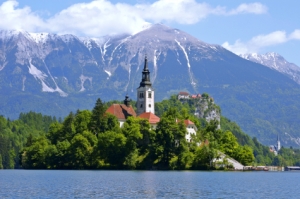Covering All the Bases in Taiwan
January 11, 2010 at 9:43 am | Posted in Asia, Taiwan | 3 CommentsTags: China, Formosa, Taipei, Taiwan
 by Victor Block
by Victor Block
It’s true that not long after arriving in Taipei I found myself stewing in traffic jams as maddening as any back home in the United States. And yes, locals lined up at the same fast-food restaurants and wore pretty much the same clothes. At times I felt I could’ve been in a Chinatown in any western city.
And yet…both here in Taiwan’s go-go capital and countryside I also discovered an abundance of sites reflecting a rich history and culture stretching back five millennia. Not just a wealth of ancient artifacts and artworks, but hundreds of active traditional temples where even in the 21st century, worshippers still pray, burn incense, and perform ancient rituals, such as burning fake paper money for deceased loved ones to spend in the realm beyond.
Nor are traditional ways of life totally a thing of the past. On the southern tip of Taiwan, I spotted laborers bent in the hot sun, planting tender rice shoots much like their ancestors thousands of years ago. Many of the aboriginal people still cling to their old way of life (the first Han Chinese didn’t reach Taiwan until the 17th century, driving its Polynesian/Malay inhabitants into the high mountains in the interior; the influx from the mainland continued for two centuries).
Han immigration was given a huge boost in 1949 when Chiang Kai-shek and some two million followers fled here as mainland China fell under communist rule. In the process of definitively turning the island into a Han country, they also endowed it with many priceless treasures from Peking’s Forbidden City. Today, those gorgeous antiques are on display at Taipei’s National Palace Museum, Taiwan’s single most important tourist attraction and one that by itself practically justifies a visit to the island; ranked with the world’s A-list museums, it houses the largest collection of Chinese artifacts anywhere. Strolling through room after room, I was awestruck by displays teeming with treasures including precious jade, bronze and porcelain artifacts; rich tapestries and embroidery; and books and scrolls filled with mesmerizing ancient calligraphy.
There’s plenty else just in Taipei to fill several busy days, too. Exhibit A: an imposing monument to Chiang Kai-Shek which includes a vast memorial hall, and the palatial National Theater and National Concert Hall. Both share a 62-acre (25-hectare) city-center compound where I spotted a number of couples, drawn by the picturesque and tranquil setting, posing for wedding photos.
Not surprisingly, traditional gardens abound. The most outstanding for me was the Lin Penyuan family garden, employing classic Confucian principles to embody a harmony of man and nature; I found it a masterpiece of serenity, reminiscent of a serene village from a bygone era.
Far less tranquil is the hustle-bustle on Hwa Hsi Street, better known as Snake Alley. Here I found myself introduced to a very different and colorful aspect of local life. Tiny, crowded sidewalk restaurants and busy shops proffer live fish and crabs, shark fins, and countless unidentifiable animal parts. The hottest action takes place at stalls crammed with cages that give the place its nickname, a-swarm with writhing serpents, and passersby are subjected to a loud and constant singsong by the vendors. The oddest thing I found was one hawking the fresh-drawn blood of snakes, touted as greatly beneficial to both libido and general health. I passed.
 Beyond Taipei, I greatly recommend Tainan, the island’s oldest city and its first capital (1663-1885). One key feature here: more than 300 intensely atmospheric temples enshrining a variety of gods — Buddhist, Taoist, folk, and animist. These range from huge imposing structures striding broad boulevards to tiny neighborhood shrines tucked away on side streets and alleyways. The Confucius Temple, built in 1665, is the oldest in Taiwan to honor the renowned philosopher. For me, even more moving was Wufei Miao (Temple of the Five Concubines), erected in the 17th century beside the tombs of a prince’s mistresses, who committed suicide when he fell in battle.
Beyond Taipei, I greatly recommend Tainan, the island’s oldest city and its first capital (1663-1885). One key feature here: more than 300 intensely atmospheric temples enshrining a variety of gods — Buddhist, Taoist, folk, and animist. These range from huge imposing structures striding broad boulevards to tiny neighborhood shrines tucked away on side streets and alleyways. The Confucius Temple, built in 1665, is the oldest in Taiwan to honor the renowned philosopher. For me, even more moving was Wufei Miao (Temple of the Five Concubines), erected in the 17th century beside the tombs of a prince’s mistresses, who committed suicide when he fell in battle.
When it comes to nature, also Taiwan shines. It’s dominated by the towering mountains that bisect the island, and the rest consists of terraced flatlands, bamboo forests and coastal plains rimmed by magnificent beaches (Fulong Beach on the northwest coast is a local favorite). You’ll find most of the most impressive settings in parks like Yangmingshan National Park near Taipei, where volcanic craters, bubbling hot springs and breathtaking mountain scenery are the top draws. At the nearby Northeast Coast National Scenic Area, I was fascinated by the restored ancient walking trail and fanciful rock formations.
There’s a reason 16th-century Portuguese explorers named this island Formosa (“beautiful”). Touristically as well as politically, it may sometimes seem overshadowed by its enormous neighbor across the strait — but I’m here to assure you that Taiwan is a classic case of “good things come in small packages.”
More information: Taiwan Tourism Bureau.
What Recession, Comrade? Shanghai Flies High
November 2, 2009 at 9:17 am | Posted in Asia, China | 1 CommentTags: China, Shanghai
by Eric Hiss

The booming skyline of Shanghai's Pudong District.
Recently back from China’s largest metropolis, my head’s still spinning — while many world cities are still in a slump, Shanghai buzzes 24/7. Orbs, obelisks, rectangles and other geometries take form hundreds of feet above ground while billboards proclaim in Chinglish: “Shanghai: With Luck and Brilliancy.” After sundown, things turn even more electric, as tour boats plying the Huangpu River and shimmering towers create a neon nightscape as brash as any Vegas strip.
Gearing up for next May’s World Expo, it seems all 22 million denizens are seeing this not only as a coming-out party for Shanghai, but a point of national pride — like the Olympics, a defining moment for China’s arrival as a superpower (another billboard: “Greeting the Expo with Civilization!”). Certainly the raw materials are present: superb cuisine and hotels, cool nightlife, and seemingly unlimited shopping. A shortlist to help you dive in:
A dramatic 950-room pair of towers, the Pudong Shangri-La (from 1550 RMB/$227 double): delivers five-star service and amenities like an award-winning spa. One tower features chandeliers, original Chinese oils, and Queen Anne-style furnishings, the other sleek, contemporary, high-gloss rosewood, leather, and silk. Floor-to-ceiling windows over the river afford among the best views in town.
As China’s first carbon-neutral property, the 26-room Urbn Hotel Shanghai (from 1,300 RMB/$190), right next to the French Concession (see below), offers luxury with a conscience, plus minimalist-mod sunken lounges, slate-lined bathrooms, raised platform beds, and rooftop garden.
Finally, for affordability and historic appeal, 12-room Old House (from 720 RMB/US$103) is an excellent, central choice in the charming French Concession neighborhood.
Foodwise, FU 1039, in a grand former residence off shopping thoroughfare Yuyuan Lu, is the real Shanghainese deal: oily, sweet and savory dishes like chilled jellyfish with spring onion oil, sweet lotus root, and slow-cooked sweet river eel in soy sauce. It’s tricky to find (down a long, unmarked lane), the antique furnishings are a tad musty, and few staffers speak English. But it’ll be one of your visit’s most memorable meals.
M On The Bund is a Deco-era gem on the historic riverside Bund promenade where you can tap into the romanticized Shanghai of the 1920’s over excellent European and North African specialties. Fantastic views across the Huangpu River and of neighboring buildings with swirling Deco adornments.
Haute Japanese is on the menu at the Shanghai outpost of Tokyo’s famed Nadaman. A striking minimalist decor of granite, natural woods and modernist lanterns set the backdrop for impeccable fare served by kimono-clad staff. The traditional kaiseki meals are especially memorable.
After dinner, hit Bar Rouge, another Bund spot that evokes retro Shanghai — albeit with decidedly modern twists: recessed red lights, sleek surfaces and a party-ready crowd of expats and locals. The scene’s pretty high-octane, but for a true Shanghai experience, head out to the expansive open-air patio and take in the glittering lights of the city and river below.
While Bar Rouge is predominately peopled by expats, the two-story JZ Club is where a bohemian, mostly local bunch sips moderately-priced cocktails and takes in live jazz. A neighborhood vibe predominates, fusing boho-chic with neighborhood-bar ambiance. Weekends are popular; go early to get a good seat (especially the cozy tables upstairs).
Now for shopping. Though America created consumerism, China plays the game as well or better — and always more cheaply. To not shop here would be like missing Paris’ Louvre or a Hawaii sunset. While the quality (and prices) of housewares, silk-lined jackets, leather furnishings and other merch at sleek boutique Shanghai Tang of match New York’s or London’s, at the “South Bund Soft Spinning Fabric Market” south of Old Shanghai, they’re as wide as the China/U.S. trade deficit. For the savvy, it’s a shopping nirvana where you can score $100 custom-made wool suits and $70 tailored silk cheongsams. With hundreds of stalls, the four-floor complex can be daunting, so stick to the first two, which have the best outlets. (Tip: local hotels like the Pudong Shangri-La can arrange for a tailor to escort you, negotiate the best deal, then tailor your design. In my case, I spotted a mandarin-style leather jacket in Shanghai Tang for US$1,000. I later described it to a shop owner and tailor in the Fabric Market who had it ready for me the next day, perfectly executed, for all of 1,000 RMB — about US$130).
In contrast to the concrete, steel and glass of most of the city, the historic French Concession, the 19th-century French merchant quarter, is an inviting respite. Among tree-lined streets and Continental-style brick-and-stone manses, shops both quirky and trendy purvey everything from hip fashion to vintage Mao-mentos. Fashionistas should check out eno on Changle Lu with its designs by young locals, while Madame Mao’s Dowry is filled with wry riffs on Mao gear and propaganda. (Note: while bartering is expected at the Fabric Market, most of these shops are no-haggle zones.)
Final note: love ‘em or hate ‘em, counterfeit goods are a reality; you can’t avoid ’em. More than a few expats and visitors were spotted recently at the A.P Shopping Center (aka the “Fake Market”) near the Shanghai Science Museum, where copies of name-brand bags, watches and luggage are on display, and Da Gu Lu (aka “DVD Street”), where knockoffs of every category are sold at dirt-cheap prices.
More info: Meet-in-Shanghai.net.
Create a free website or blog at WordPress.com.
Entries and comments feeds.

